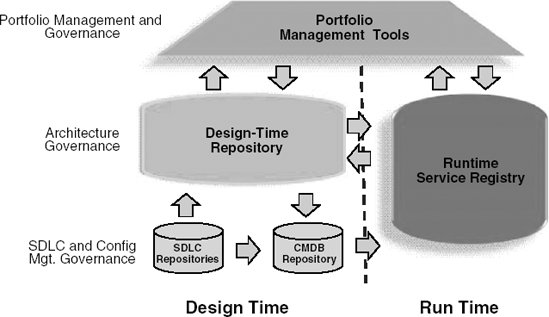8.2. LIFECYCLE GOVERNANCE TOOLS AND PLATFORMS
There are a variety of tools and platforms that support lifecycle governance processes and requirements, from enterprise architecture documentation and repository tools to design-time solutions, tools for quality assurance and testing, and of course runtime governance and feedback mechanisms. (See Exhibit 8.2.)
8.2.1. Design-Time versus Runtime Governance
When reviewing governance tools, it is important to consider the differences in usage and performance characteristics required by these two very different perspectives. Design-time governance platforms have these key characteristics:
They guide production and consumption of services from initial inception to selection for use in end-user applications.
They involve a broad set of asset types—components, legacy APIs, design patterns, and so forth—beyond services and schemas.
They must present information to multiple roles in their preferred views—browser, IDE integration, reports, and so forth.
They must integrate with heterogeneous development tools—SCM systems, document management systems, quality assurance and test systems, defect tracking systems, and so forth.
Figure 8.2. Lifecycle Governance Solution Landscape

Runtime governance platforms present a largely complementary set of usage characteristics:
They deal with how a service behaves when called, how various policies (e.g., security) ...
Get Service-Oriented Architecture Governance for the Services Driven Enterprise now with the O’Reilly learning platform.
O’Reilly members experience books, live events, courses curated by job role, and more from O’Reilly and nearly 200 top publishers.

